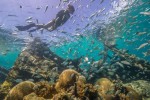The Research Natural Area (RNA) was designated as an area of special protection within Dry Tortugas National Park in 2007. The RNA was designed to work along with the two existing ecological reserves as a network to protect the shallow water habitats and reef fish species found in the Tortugas.
Recent research shows that the abundance of important fishery species such as mutton snapper, yellowtail snapper, and hogfish has increased inside each of the marine protected areas in the Tortugas, which demonstrates how these no-take marine reserves are working together as a network to protect fish throughout their life history in the different habitats of the Tortugas.
FWC commissioners met recently and extended the RNA protections for another 20 years, which will hopefully allow the reef fish populations to continue to recover and provide sustainable fisheries into the future.
Almost 70 miles (113 km) west of Key West lies the remote Dry Tortugas National Park. This 100-square mile park is mostly open water with seven small islands. Accessible only by boat or seaplane, the park is known the world over as the home of magnificent Fort Jefferson, picturesque blue waters, superlative coral reefs and marine life, and the vast assortment of bird life that frequents the area.

Dry Tortugas National Park is home to history and natural wonders above and below the water’s’ surface. The park’s corals and seagrass communities are among the most vibrant in the Florida Keys. Shipwrecks are just as abundant as marine life here at the park.
Learn more about our diving and snorkeling sites.
Remember to not disturb coral or shells. All coral, living and dead, is protected from collection. Shipwrecks and all historic artifacts are protected by law. You must display an approved dive flag when snorkeling outside of the designated snorkel area.
For your safety never snorkel alone. Always use the buddy system when entering the water.
